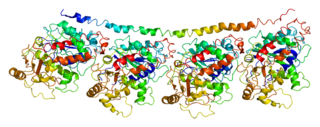Myc is a family of regulator genes and proto-oncogenes that code for transcription factors. The Myc family consists of three related human genes: c-myc (MYC), l-myc (MYCL), and n-myc (MYCN). c-myc was the first gene to be discovered in this family, due to homology with the viral gene v-myc.

Prefoldin (GimC) is a superfamily of proteins used in protein folding complexes. It is classified as a heterohexameric molecular chaperone in both archaea and eukarya, including humans. A prefoldin molecule works as a transfer protein in conjunction with a molecule of chaperonin to form a chaperone complex and correctly fold other nascent proteins. One of prefoldin's main uses in eukarya is the formation of molecules of actin for use in the eukaryotic cytoskeleton.

Protein deglycase DJ-1, also known as Parkinson disease protein 7, is a protein which in humans is encoded by the PARK7 gene.

Cell division control protein 6 homolog is a protein that in humans is encoded by the CDC6 gene.

T-cell lymphoma invasion and metastasis-inducing protein 1 is a protein that in humans is encoded by the TIAM1 gene.

Nuclear transcription factor Y subunit beta is a protein that in humans is encoded by the NFYB gene.

Tubulin alpha-4A chain is a protein that in humans is encoded by the TUBA4A gene.

Proto-oncogene serine/threonine-protein kinase Pim-1 is an enzyme that in humans is encoded by the PIM1 gene.

Neuronal acetylcholine receptor subunit alpha-1, also known as nAChRα1, is a protein that in humans is encoded by the CHRNA1 gene. The protein encoded by this gene is a subunit of certain nicotinic acetylcholine receptors (nAchR).

Nuclear transcription factor Y subunit gamma is a protein that in humans is encoded by the NFYC gene.

Prefoldin subunit 1 is a protein that in humans is encoded by the PFDN1 gene.

A kinase anchor protein 1, mitochondrial is an enzyme that in humans is encoded by the AKAP1 gene.

A-kinase anchor protein 8 is an enzyme that, in humans, is encoded by the AKAP8 gene.

Prefoldin subunit 6 is a protein that in humans is encoded by the PFDN6 gene.

Tubulin-specific chaperone D is a protein that in humans is encoded by the TBCD gene.

C-Myc-binding protein is a protein that in humans is encoded by the MYCBP gene.

Prefoldin subunit 2 is a protein that in humans is encoded by the PFDN2 gene.

Prefoldin subunit 4 is a protein that in humans is encoded by the PFDN4 gene.

RNA-binding motif, single-stranded-interacting protein 1 is a protein that in humans is encoded by the RBMS1 gene.

AMY-1-associating protein expressed in testis 1 is a protein that in humans is encoded by the MAATS1 gene.




















